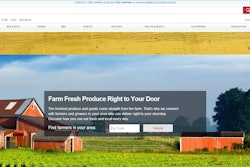
Online grocery shopping is big business in the UK, and is expected to get bigger: according to analysts at IGD, the UK online home grocery market is expected to double in value over the next five years, far exceeding the 18% growth expected for the total grocery market over this period (source: www.igd.com). More and more UK consumers are turning their backs on shopping in stores, opting to do their grocery shopping online in the comfort of their home and office. And why should they go to the grocery store when they can get the same products – fresh produce, meat, dry goods, paper goods, etc. – delivered to their home within a one-hour time window for a small delivery charge of only a few pounds or free at certain order levels?
Four of the five big grocery chains in the UK offer home delivery, with the fifth chain entering the market in January 2014. The IGD reports that in 2013 the UK grocery market was worth £169.7 billion, an increase of 3.7% on 2012 with online grocery shopping accounting for £6.5 billion (3.8%) of the total (Source: www.igd.com). According to Fitch Ratings (source: www.fitchratings.com) online grocery sales currently account for just 1% of the $631 billion US grocery market. The good news for the US grocery business (and for consumers) is that this market is set for a period of rapid expansion with Super Market News forecasting a 4% growth in online grocery sales in 2014.
But, there are some hard lessons that need to be learned along the way – after all the UK operators’ paths to online grocery success have not always been easy. The ‘home shopping’ model has been refined and reviewed over the years with some of the UK’s biggest named supermarkets struggling to get the right model in place.
So before US grocery operators dip their toe into this lucrative revenue stream it’s well worth taking a look at how this model has evolved in the UK to become as successful as it has, and why different retailers have approached the challenge in different ways.
Lessons Learned from the UK
The top UK Grocers offer home delivery of fresh produce, meats, dairy, dry goods and more to consumers. Customers can order by a certain time for delivery the next day or any subsequent day, subject to an available delivery slot. Consumers select a one to two-hour time slot for their delivery and pay only a few dollars for this luxury. Certain grocers offer free delivery for amounts over a certain level, typically £50 or more. Deliveries are made between early morning and late evening.
As we have established the UK home grocery market is a must-have part of the top retailers businesses accounting for 3.8% of all sales; a figure that is predicted to increase further in 2014. So how do the UK operators do it?
Much of the UK grocery home delivery market uses the store-delivery model. In other words, home delivery goods are picked in the same store as used by the public, and a small fleet of delivery vans at each store then completes the home deliveries. The advantages of this approach are that crucially, this model ‘piggy-backs’ almost the whole existing supply chain infrastructure (all but the last mile delivery) that means that the amount of planning and effort to set up a home delivery operation is minimal. This is how UK home delivery operations traditionally began, and some continue to operate in this way. But there are two drawbacks to this model. Not all grocery stores stock the full product range so deliveries that make it to the customer doorstep are likely to include some product substitutions (i.e. where the in store grocery picker selects an alternative item based on their own judgments of what the customer wants). This can lead to customer dissatisfaction. The other problem is the impact on the in-store shopper who will now have to share the store with the in-store pickers, many of whom will be pushing large, specially-designed home shopping carts around in store.
For these two reasons many of the UK’s grocery retailers have opted for a ‘dark store’ option. A dark store is a dedicated location, set up to fulfil online grocery orders. Dark stores are actually laid out like a big warehouse with different areas holding different products. For example, there are chilled areas in the warehouse for produce and frozen goods. Other areas for dry goods and ambient products. Shelves are erected in each area to hold containers of cardboard boxes. Pickers receive orders and travel the aisles to pick products from the containers, filling bags with items or carts of items, which are later put into delivery bags. Some of the grocers color-coordinate the delivery bags to denote products that must be refrigerated immediately upon delivery, and those that can wait to be put up at the buyer’s convenience. The main point of difference is that the dark store has no customers and no checkouts. They vary in design with some featuring more conveyor belt automation than others.
A major disadvantage of this approach is the huge up-front investment required, and the consequent delay in getting the operation started. But, there are some significant advantages which is why more UK grocery operators are opting for this model. The main advantages include: store capacity in terms of physical room available to pick and pack orders; increased efficiencies with a higher volume of units picked per hour; improved stock quality as stock rotation can be managed more efficiently, which will have a positive impact on consumer satisfaction; less pressure on existing stores as they don’t have to cope with the additional activity associated with home deliveries; extended operating hours as dark stores are not restricted by normal store opening times, allowing an operation to work 24/7 if required; more extensive product range availability as dark stores tend to be larger than their traditional grocery store counterparts; and centralized route planning where routing optimization software, such as that provided by Paragon Software Systems, can be used to ensure maximum drops per vehicle.
US Grocery Home Delivery Challenges
So there are a lot of challenges associated with online grocery delivery, like the cost of building warehouses and the rising price of gas and transportation. But there are more than 115 million households in the US, so the ability to get even a small piece of the grocery business means billions of dollars for companies. To benefit from this, companies will have to figure out how to make deliveries affordable and avoid the obstacles around the delivery, such as harsh winter weather and the storage of food before it goes out, as well as the need to offer and meet promised delivery windows reliably.
Overcoming challenges in the US grocery home delivery market requires collaboration between the retailers and customers. Consumers need to be prepared to pay for this service. Plus, in the US there is a driver shortage, so anything that can be done to support the driver, such as minimizing wasted mileage, on-site delays and repeat deliveries due to missed time windows is critical. Providing realistic delivery windows is also key for the acceptance of US grocery home delivery. Consumers don’t want to wait hours for their groceries.
Technology to help
So what resources are available to help be successful in this market? A key element of successful grocery home shopping is the ability of the retailer to promise a 1 or 2 hour delivery time window. Whether using a store-based or Dark Store approach, you need to plan optimized delivery routes that take full account of promised time windows. Otherwise delivery costs can escalate (with inefficient routing) and, worse, customer service can suffer. The good news is that there are software suppliers who have worked with the UK’s leading grocery chains and have the expertise to help US operators achieve similar levels of success. Paragon Software Systems (www.paragonrouting.com) is one such company. As a leading provider of truck routing and scheduling optimization solutions, Paragon is no stranger to the changes and challenges faced by food retailers. Most of the UK’s top food retailers rely on Paragon-generated routes and schedules for some part of their distribution business. Whether this be ‘batch planning’, which focuses on getting products from DC’s into stores in a timely fashion for consumers and/or in-store pickers, through to the allocation of reliable one-hour time delivery slots for home delivery operators, Paragon has the expertise required to help distribution operators to run an optimized, cost-efficient and reliable transportation operation.
UK Grocery Home Delivery Model Successes
Why is the UK grocery home delivery model more widely accepted compared to US home delivery? First off, the UK is denser in population. Critical mass of consumers is much more prevalent, not like in the US, which is much more spread out. Consequently, US-based home delivery grocers often only deliver to small areas in order to be cost-effective and meet the service requirement. To expand beyond this and exploit the forecast growth opportunities, US companies can take a close look at the UK market. UK operators have tried different models, learned many lessons, but are now reaping the rewards as a result of offering good quality home delivery services.
Bottom Line on the US Grocery Delivery Forefront
There are a lot of challenges associated with home grocery delivery in the US, but the additional revenue potential of this largely untapped market is huge. Retailers will need to spend millions of dollars to enter the home delivery market including building new fulfillment centers or dark stores, creating mobile and online apps, and overhauling technology systems to enable home delivery of orders. However, Kantar Retail, an industry analyst group targeting online retail, forecasts that by 2020 online penetration of grocery sales will more than quadruple and represent nearly USD50 billion in sales. They predict that US online grocery shopping is about to explode, and it’s not a matter of “if,” but “WHEN.” Are you ready?



















